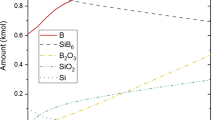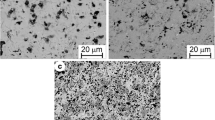Abstract
Static oxidation kinetics of Ti-25Al-10Nb-3V-1Mo (atomic percent) were investigated in air over the temperature range of 650–1000°C using thermogravimetric analysis. The oxidation kinetics were complex at all exposure temperatures and displayed up to two distinct stages of parabolic oxidation. Breakaway oxidation occurred after long exposure times at high temperatures. Oxidation products were determined using x-ray diffraction techniques, electron microprobe analysis, and energy dispersive x-ray analysis. Oxide scale morphology was examined using scanning electron microscopy of the surfaces and cross-sections of oxidation specimens. The oxides during the parabolic stages were compact and multilayered, consisting primarily of TiO2 doped with Nb, a top layer of Al2O3 and a thin bottom layer of TiN. The transition between the first and second parabolic stage is linked to the formation of a TiAl layer at the oxide-metal interface. Porosity also formed in the TiO2 layer during the second stage, causing degradation of the oxide and breakaway oxidation.
Similar content being viewed by others
References
R. A. Perkins, K. T. Chiang, and G. H. Meier,Scripta Metall. 21, 1505–1510 (1987).
S. N. Sankaran, R. K. Clark, J. Unnam, and K. E. Wiedemann, Oxidation Characteristics of Ti-14Al-21Nb (wt.%) Ingot Alloy, NASA TP 3012, 1990.
G. H. Meier, D. Appalonia, R. A. Perkins, and K. T. Chiang, inOxidation of High-Temperature Intermetallics, T. Grobstein and J. Doychak, eds. (The Minerals, Metals & Materials Society, 1989), pp. 185–193.
G. Welsch and A. I. Kahveci, inOxidation of High-Temperature Intermetallics, T. Grobstein and J. Doychak, eds. (The Minerals, Metals & Materials Society, 1989), pp. 207–218.
R. A. Perkins and K. T. Chiang, inOxidation of High-Temperature Intermetallics, T. Grobstein and J. Doychak, eds. (The Minerals, Metals & Materials Society, 1989), pp. 157–169.
M. Khobaib and F. W. Vahldiek, inSpace Age Metals Technology: Proceedings of the Second International SAMPE Metals and Metals Processing Conference, F. H. Froes and Ray A. Cull, eds. (Society for the Advancement of Material and Process Engineering, Covina, CA, 1988), pp. 262–270.
P. Kofstad, P. B. Anderson, and O. J. Krudtaa,J. Less-Common Met. 3, 89–97 (1961).
K. E. Wiedemann and J. Unnam,J. Appl. Phys. 58, 1095 (1985).
K. E. Wiedmann, S. N. Sankaran, R. K. Clark, and T. A. Wallace, inOxidation of High-Temperature Intermetallics, T. Grobstein and J. Doychak, eds. (The Minerals, Metals & Materials Society, 1989), pp. 195–206.
M. J. Graham, D. Caplan, and M. Cohen,J. Electrochem. Soc. 119, 1265–1267 (1972).
G. Bertrand, K. Jarraya, and J. M. Chaix,Oxid. Met. 21, 1–19 (1983).
Author information
Authors and Affiliations
Rights and permissions
About this article
Cite this article
Wallace, T.A., Clark, R.K., Wiedemann, K.E. et al. Oxidation characteristics of Ti-25Al-10Nb-3V-1Mo. Oxid Met 37, 111–124 (1992). https://doi.org/10.1007/BF00665185
Received:
Revised:
Issue Date:
DOI: https://doi.org/10.1007/BF00665185




